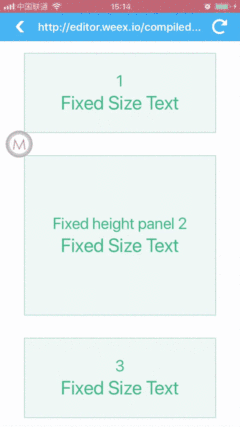# 适配不同尺寸的屏幕
简介
本文将介绍 Weex 适配不同尺寸屏幕的方法以及横竖屏动态切换时如何自适应。
# Weex 如何将前端样式值转换为系统坐标值
以 iOS 为例,在应用启动时,Weex 获取当前屏幕宽度作为全局默认值。在 iOS 系统上该宽度为实际像素/屏幕比例后的 UIKit 宽度。比如 iPhone6 为 375。
@implementation WXCoreBridge
+ (void)install
{
static dispatch_once_t onceToken;
dispatch_once(&onceToken, ^{
WeexCore::WXCoreEnvironment* env = WeexCore::WXCoreEnvironment::getInstance();
env->SetPlatform(OS_iOS);
env->AddOption("scale", "1");
CGSize screenSize = [UIScreen mainScreen].bounds.size;
env->SetDeviceWidth(std::to_string(screenSize.width));
env->SetDeviceHeight(std::to_string(screenSize.height));
...
...
}
2
3
4
5
6
7
8
9
10
11
12
13
14
15
16
创建的每个 WXSDKInstance,其默认的 viewPortWidth 为 750px。
// The default screen width which helps us to calculate the real size or scale in different devices.
static const CGFloat WXDefaultScreenWidth = 750.0;
2
当指定 CSS 样式值为 "375px" 时,Weex 在接收到该样式后,自动根据当前屏幕宽度和当前 Instance 的 viewPortWidth 计算出在 iOS 系统上,对应的 UIKit 坐标值为:
dimension(UIKit) = dimensionPx(CSS) / viewPortWidth(instance) * globalScreenWidth
代入后:dimension(UIKit) = 375 / 750 * 375 = 187.5
之后 Weex 排版引擎使用 187.5 来排版,并最终将排版后的结果设置给 iOS UIView。之后没有坐标转换过程了。
# 为什么 Weex 页面不支持横竖屏切换
如上文所述,Weex 最终将原始样式值转换为平台 UI 系统的坐标值,之后原始样式值被丢弃。这个有一定历史原因,且当页面非常大或复杂时,丢弃后可以节省很多内存,因此原始样式值被丢弃。
同时,目前 Weex 不支持百分比布局,大量竖屏页面使用 750px 的 viewPortWidth 值为基准进行开发,页面里的坐标值都是根据 750px 为一个屏幕宽度换算后的值。
当屏幕发生旋转后,比如 iPhone6 手机,旋转后的 “宽 * 高” 为 “667 * 375”。此时我们需要原始的样式值来重新计算出设置给排版引擎的坐标值,如前文所说,排版引擎接收的是 iOS UIKit 的坐标值。这个时候对于仍然为 "375px" 的样式,其计算出的 UIKit 坐标值为:
dimension(UIKit) = 375 / 750 * 667 = 333.5
仍然为宽屏下的屏幕宽度一半。
但是因为原始样式值被丢弃,我们不能支持横竖屏切换。
# 屏幕参数接口
我们通过添加一系列接口让 Weex 使用者可以控制排版参数。
# 一、设置页面使用的 viewPortWidth
const meta = weex.requireModule('meta');
meta.setViewport({
width: 800
});
2
3
4
- ios:
WXSDKInstance* instance = [[WXSDKInstance alloc] init];
[instance setViewportWidth:800.f];
2
- Android:
WXSDKInstance instance = new WXSDKInstance(mContext);
instance.setInstanceViewPortWidth(800);
2
# 二、设置页面使用的 deviceWidth
WARNING
Android暂不支持
const meta = weex.requireModule('meta');
meta.setViewport({
deviceWidth: 375,
deviceHeight: 800
});
2
3
4
5
WXSDKInstance* instance = [[WXSDKInstance alloc] init];
[instance setPageRequiredWidth:375.f height:800.f];
2
[WXSDKEngine setGlobalDeviceSize:CGSizeMake([UIScreen mainScreen].bounds.size.width, [UIScreen mainScreen].bounds.size.height)];
# 三、设置页面保留原始 CSS 样式值 V0.25+
const meta = weex.requireModule('meta');
meta.setViewport({
reserveCssStyles: true
});
2
3
4
- ios:
WXSDKInstance* instance = [[WXSDKInstance alloc] init];
[instance setPageKeepRawCssStyles];
2
- Android:
WXSDKInstance instance = new WXSDKInstance(mContext);
instance.setPageKeepRawCssStyles();
2
# 四、强制页面重新排版 V0.25+
- ios:
[instance reloadLayout];
- Android:
instance.reloadPageLayout();
# 使用场景
# 一、不可旋转屏幕的应用
如果应用不支持屏幕旋转,你可以不用关心以上问题。当 Weex 启动时,会自动获取当前屏幕宽度作为全局宽度,所有之后创建的 Weex 页面都会使用该宽度。
# 二、某个特殊页面支持横竖屏切换 V0.25+
1、设置页面保留原始 CSS 样式值
- ios:
CGFloat w = [UIScreen mainScreen].bounds.size.width;
CGFloat h = [UIScreen mainScreen].bounds.size.height;
[_instance setPageRequiredWidth:w height:h];
[_instance reloadLayout];
2
3
4
- Android:
instance.resetDeviceDisplayOfPage();
instance.reloadPageLayout();
2
你可以使用最新 Playground 扫码示例 (opens new window),要在控制面板里允许屏幕自动旋转。

# 三、注意
对于不希望受屏幕宽度和 viewPortWidth 影响的尺寸,请使用 'wx' 单位。
